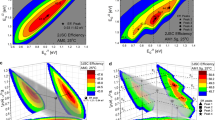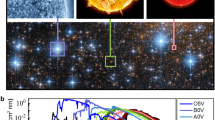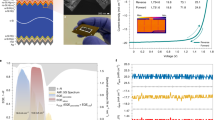Abstract
Single-junction flat-plate terrestrial solar cells are fundamentally limited to about 30% solar-to-electricity conversion efficiency, but multiple junctions and concentrated light make much higher efficiencies practically achievable. Until now, four-junction III–V concentrator solar cells have demonstrated the highest solar conversion efficiencies. Here, we demonstrate 47.1% solar conversion efficiency using a monolithic, series-connected, six-junction inverted metamorphic structure operated under the direct spectrum at 143 Suns concentration. When tuned to the global spectrum, a variation of this structure achieves a 1-Sun global efficiency of 39.2%. Nearly optimal bandgaps for six junctions were fabricated using alloys of III–V semiconductors. To develop these junctions, it was necessary to minimize threading dislocations in lattice-mismatched III–V alloys, prevent phase segregation in metastable quaternary III–V alloys and understand dopant diffusion in complex structures. Further reduction of the series resistance within this structure could realistically enable efficiencies over 50%.
This is a preview of subscription content, access via your institution
Access options
Access Nature and 54 other Nature Portfolio journals
Get Nature+, our best-value online-access subscription
$29.99 / 30 days
cancel any time
Subscribe to this journal
Receive 12 digital issues and online access to articles
$119.00 per year
only $9.92 per issue
Buy this article
- Purchase on Springer Link
- Instant access to full article PDF
Prices may be subject to local taxes which are calculated during checkout






Similar content being viewed by others
Data availability
All data generated or analysed during this study are included in the published aticle and its Supplementary Information and Source Data files.
References
Shockley, W. & Queisser, H. J. Detailed balance limit of efficiency of p-n junction solar cells. J. Appl. Phys. 32, 510–519 (1961).
Steiner, M. A. et al. Optical enhancement of the open-circuit voltage in high quality GaAs solar cells. J. Appl. Phys. 113, 123109 (2013).
Miller, O. D., Yablonovitch, E. & Kurtz, S. R. Strong internal and external luminescence as solar cells approach the Shockley–Queisser limit. IEEE J. Photovolt. 2, 303–311 (2012).
Henry, C. H. Limiting efficiencies of ideal single and multiple energy gap terrestrial solar cells. J. Appl. Phys. 51, 4494–4500 (1980).
Marti, A. & Araujo, G. L. Limiting efficiencies for photovoltaic energy conversion in multigap systems. Sol. Energ. Mater. Sol. Cells 43, 203–222 (1996).
McMahon, W. E., Friedman, D. J. & Geisz, J. F. Multijunction solar cell design revisited: disruption of current-matching by atmospheric absorption bands. Prog. Photovolt: Res. Appl. 25, 850–860 (2017).
Green, M. A. Radiative efficiency of state-of-the-art photovoltaic cells. Prog. Photovolt: Res. Appl. 20, 472–476 (2012).
Rau, U. Reciprocity relation between photovoltaic quantum efficiency and electroluminescent emission of solar cells. Phys. Rev. B 76, 085303 (2007).
Onabe, K. Calculation of miscibility gap in quaternary InGaPAs with strictly regular solution approximation. Jpn. J. Appl. Phys. 21, 797–798 (1982).
Geisz, J. F. et al. 40.8% efficient inverted triple-junction solar cell with two independently metamorphic junctions. Appl. Phys. Lett. 93, 123505 (2008).
Guter, W. et al. Current-matched triple-junction solar cell reaching 41.1% conversion efficiency under concentrated sunlight. Appl. Phys. Lett. 94, 223504 (2009).
France, R. M., Dimroth, F., Grassman, T. J. & King, R. R. Metamorphic epitaxy for multijunction solar cells. MRS Bull. 41, 202–209 (2016).
Stringfellow, G. Spinodal decomposition and clustering in III/V alloys. J. Electron. Mater. 11, 903–918 (1982).
Stringfellow, G. B. The importance of lattice mismatch in the growth of GaxIn1-xP epitaxial crystals. J. Appl. Phys. 43, 3455–3460 (1972).
Oshima, R., France, R. M., Geisz, J. F., Norman, A. G. & Steiner, M. A. Growth of lattice-mismatched GaInAsP grown on vicinal GaAs(001) substrates within the miscibility gap for solar cells. J. Cryst. Growth 458, 1–7 (2017).
Dimroth, F. et al. Four-junction wafer-bonded concentrator solar cells. IEEE J. Photovolt. 6, 343–349 (2016).
Wanlass, M. W. et al. Monolithic ultra-thin GaInP/GaAs/GaInAs tandem solar cells. In 4th World Conference on Photovoltaic Energy Conversion 729–732 (IEEE, 2006); https://doi.org/10.1109/WCPEC.2006.279559
France, R. M. et al. Design flexibility of ultra-high efficiency four-junction inverted metamorphic solar cells. IEEE J. Photovolt. 6, 578–583 (2016).
Young, J. L. et al. Direct solar-to-hydrogen conversion via inverted metamorphic multi-junction semiconductor architectures. Nat. Energy 2, 17028 (2017).
Omair, Z. et al. Ultraefficient thermophotovoltaic power conversion by band-edge spectral filtering. PNAS 116, 15356–15361 (2019).
Garcia, I., Geisz, J. F., France, R. M., Steiner, M. A. & Friedman, D. J. Component integration strategies in metamorphic 4-junction III-V concentrator solar cells. AIP Conf. Proc. 1616, 41–44 (2014).
Geisz, J. F. et al. Building a six-junction inverted metamorphic concentrator solar cell. IEEE J. Photovolt. 8, 626–632 (2018).
Garcia, I. et al. Metamorphic Ga0.76In0.24As/GaAs0.75Sb0.25 tunnel junctions grown on GaAs substrates. J. Appl. Phys. 116, 074508 (2014).
Matthews, J. W. & Blakeslee, A. E. Defects in epitaxial multilayers I. Misfit dislocations. J. Cryst. Growth 27, 118–125 (1974).
Andre, C. L. et al. Impact of dislocation densities on n +/p and p +/n junction GaAs diodes and solar cells on SiGe virtual substrates. J. Appl. Phys. 98, 014502 (2005).
Schulte, K. L., France, R. M. & Geisz, J. F. Highly transparent compositionally graded buffers for new metamorphic multijunction solar cell designs. IEEE J. Photovolt. 7, 347–353 (2017).
Quitoriano, N. J. & Fitzgerald, E. A. Relaxed, high-quality InP on GaAs by using InGaAs and InGaP graded buffers to avoid phase separation. J. Appl. Phys. 102, 033511 (2007).
McMahon, W. E. et al. Ordering-enhanced dislocation glide in III-V alloys. J. Appl. Phys. 114, 203506 (2013).
Suzuki, T. & Gomyo, A. Sublattice ordering in GaInP and AlGaInP: effects of substrate orientations. J. Cryst. Growth 99, 60–67 (1990).
Geisz, J. F. et al. Six-junction concentrator solar cells. AIP Conf. Proc. 2012, 040004 (2018).
Andreev, V. M., Grilikhes, V. A. & Rumyantsev, V. D. Photovoltaic Conversion of Concentrated Sunlight (Wiley, 1997).
Luque, A. & Hegedus, S. Handbook of Photovoltaic Science and Engineering (Wiley, 2007).
Fraas, L. & Partain, L. Solar Cells and Their Applications (Wiley, 2010).
Badescu, V. Maximum concentration ratio of direct solar radiation. Appl. Opt. 32, 2187–2189 (1993).
Jones-Albertus, R. E. & Sheldon, M. J. Reverse heterojunctions for solar cells. US patent 2013/0263923 A1 (2013).
Steiner, M. A. et al. Reverse heterojunction (Al)GaInP solar cells for improved efficiency at concentration. IEEE J. Photovolt. 10, 487–494 (2020).
Saive, R. et al. Effectively transparent front contacts for optoelectronic devices. Adv. Opt. Mater. 4, 1470–1474 (2016).
Ward, J. S. et al. High aspect ratio electrodeposited Ni/Au contacts for GaAs-based III-V concentrator solar cells. Prog. Photovolt: Res. Appl. 23, 646–653 (2015).
Geisz, J. F. et al. Pathway to 50% efficient inverted metamorphic concentrator solar cells. AIP Conf. Proc. 1881, 040003 (2017).
Schulte, K. L., Steiner, M. A., Young, M. R. & Geisz, J. F. Internal resistive barriers related to Zn diffusion during the growth of inverted metamorphic multi-junction solar cells. IEEE J. Photovolt. 9, 167–173 (2019).
Deppe, D. G. Thermodynamic explanation to the enhanced diffusion of base dopant in AlGaAs-GaAs npn bipolar transistors. Appl. Phys. Lett. 56, 370–372 (1990).
Takamoto, T. et al. Mechanism of Zn and Si diffusion from a highly doped tunnel junction for InGaP/GaAs tandem solar cells. J. Appl. Phys. 85, 1481–1486 (1999).
Galiana, B., Rey-Stolle, I., Baudrit, M., García, I. & Algora, C. A comparative study of BSF layers for GaAs-based single-junction or multijunction concentrator solar cells. Semicond. Sci. Technol. 21, 1387–1392 (2006).
Green, M. A. et al. Solar cell efficiency tables (version 54). Prog. Photovolt: Res. Appl. 27, 565–575 (2019).
Chiu, P. T. et al. Direct semiconductor bonded 5J cell for space and terrestrial applications. IEEE J. Photovolt. 4, 493–497 (2014).
Geisz, J. F. et al. Generalized optoelectronic model of series-connected multijunction solar cells. IEEE J. Photovolt. 5, 1827–1839 (2015).
Roensch, S., Hoheisel, R., Dimroth, F. & Bett, A. W. Subcell I-V characteristic analysis of GaInP/GaInAs/Ge solar cells using electroluminescence measurements. Appl. Phys. Lett. 98, 251113 (2011).
Kirchartz, T. et al. Internal voltages in GaInP/GaInAs/Ge multijunction solar cells determined by electroluminescence measurements. Appl. Phys. Lett. 92, 123502 (2008).
Geisz, J. F., Steiner, M. A., Garcia, I., Kurtz, S. R. & Friedman, D. J. Enhanced external radiative efficiency for 20.8% efficient single-junction GaInP solar cells. Appl. Phys. Lett. 103, 041118 (2013).
Geisz, J. F., Levander, A. X., Norman, A. G., Jones, K. M. & Romero, M. J. In situ stress measurement for MOVPE growth of high efficiency lattice-mismatched solar cells. J. Cryst. Growth 310, 2339–2344 (2008).
France, R. M., McMahon, W. E., Kang, J., Steiner, M. A. & Geisz, J. F. In situ measurement of CuPt alloy ordering using strain anisotropy. J. Appl. Phys. 115, 053502 (2014).
Breiland, W. G. & Killeen, K. P. A virtual interface method for extracting growth rates and high temperature optical constants from thin semiconductor films using in situ normal incidence reflectance. J. Appl. Phys. 78, 6726–6736 (1995).
France, R. M. et al. Reduction of crosshatch roughness and threading dislocation density in metamorphic GaInP buffers and GaInAs solar cells. J. Appl. Phys. 111, 103528 (2012).
Garcia, I., France, R. M., Geisz, J. F. & Simon, J. Thin, high quality GaInP compositionally graded buffer layers grown at high growth rates for metamorphic III-V solar cell applications. J. Cryst. Growth 393, 64–69 (2014).
Schulte, K. L. et al. Reduced dislocation density in GaxIn1−xP compositionally graded buffer layers through engineered glide plane switch. J. Cryst. Growth 464, 20–27 (2017).
Schermer, J. J. et al. High rate epitaxial lift-off of InGaP films from GaAs substrates. Appl. Phys. Lett. 76, 2131–2133 (2000).
Tatavarti, R. et al. Lightweight, low cost GaAs solar cells on 4″ epitaxial liftoff (ELO) wafers. In 33rd Photovoltaic Specialists Conference 1–4 (IEEE, 2008); https://doi.org/10.1109/PVSC.2008.4922900
Bedell, S. W. et al. Kerf-less removal of Si, Ge, and III–V layers by controlled spalling to enable low-cost PV technologies. IEEE J. Photovolt. 2, 141–147 (2012).
France, R. M. et al. Quadruple junction inverted metamorphic concentrator devices. IEEE J. Photovolt. 5, 432–437 (2015).
Barrigón, E., Espinet, P., Contreras, Y. & Rey-Stolle, I. Implications of low breakdown voltage of component subcells on external quantum efficiency measurements of multijunction solar cells. Prog. Photovolt: Res. Appl. 23, 1597–1607 (2015).
Steiner, M. A. et al. Measuring IV curves and subcell photocurrents in the presence of luminescent coupling. IEEE J. Photovolt. 3, 879–887 (2013).
Moriarty, T., Jablonski, J. & Emery, K. Algorithm for building a simulator spectrum for NREL one-sun multi-source simulator. In 38th Photovoltaic Specialists Conference (IEEE, 2012); https://doi.org/10.1109/PVSC.2012.6317838
Moriarty, T., France, R. & Steiner, M. Rapid, enhanced IV characterization of multi-junction PV devices under one Sun at NREL. In 42nd IEEE Photovoltaic Specialists Conference (IEEE, 2015); https://doi.org/10.1109/PVSC.2015.7355845
Osterwald, C. R., Wanlass, M. W., Moriarty, T., Steiner, M. A. & Emery, K. A. Concentrator cell efficiency measurement errors caused by unfiltered xenon flash solar simulators. AIP Conf. Proc. 1616, 149–153 (2014).
Osterwald, C. R., Emery, K. A., Myers, D. R. & Hart, R. E. Primary reference cell calibrations at SERI: history and methods. In 21st IEEE Photovoltaic Specialists Conference 1062 (IEEE, 1990); https://doi.org/10.1109/PVSC.1990.111780
Acknowledgements
The authors thank W. Olavarría and M. Young for cell fabrication. I. Garcia, N. Jain and E. Perl developed the initial components of the 6J IMM as referenced. We thank D. Friedman for managerial support and helpful discussions. J. Olson, S. Kurtz and M. Wanlass laid the groundwork for all multijunction solar cells at NREL. Thanks to J. K. Geisz for help with photography and A. Hicks for graphics design. This work was authored by the National Renewable Energy Laboratory, operated by Alliance for Sustainable Energy, LLC, for the US Department of Energy (DOE) under Contract no. DE-AC36-08GO28308. Funding was provided by the US Department of Energy Efficiency and Renewable Energy Solar Energy Technologies Office under Agreement Number 30293. The views expressed herein do not necessarily represent the views of the DOE or the US Government.
Author information
Authors and Affiliations
Contributions
The 6J IMM epilayer structure on 2°B was designed by R.F. following initial designs by K.S. and M.S. on 6°A; T.S. of the independent cell performance team at NREL verified initial performance measurements from R.F. and J.G; 6J equipment development and junction analysis were performed by J.G.; uncertainty analysis was performed by T.M; A.N. performed TEM; H.G performed CL; M.Y. performed SIMS; J.G. and R.F. wrote the manuscript and all other authors provided feedback. The project was led by J.G.
Corresponding author
Ethics declarations
Competing interests
The authors declare no competing interests.
Additional information
Publisher’s note Springer Nature remains neutral with regard to jurisdictional claims in published maps and institutional affiliations.
Supplementary information
Supplementary Information
Supplementary Figs. 1–13, Tables 1–5 and ref. 1.
Source data
Source Data Fig. 1
Compressed folder containing source data for Figs. 1c and 6 tiff images used to construct Figs. 1a and 1d
Source Data Fig. 3
Compressed folder containing source data for Figs. 3b and 3c
Source Data Fig. 4
Compressed folder containing source data for Fig. 4a and JV curves in Fig. 4b
Source Data Fig. 5
Source data for Fig. 5
Source Data Fig. 6
Compressed folder containing source data for Figs. 6a and 6b
Rights and permissions
About this article
Cite this article
Geisz, J.F., France, R.M., Schulte, K.L. et al. Six-junction III–V solar cells with 47.1% conversion efficiency under 143 Suns concentration. Nat Energy 5, 326–335 (2020). https://doi.org/10.1038/s41560-020-0598-5
Received:
Accepted:
Published:
Issue Date:
DOI: https://doi.org/10.1038/s41560-020-0598-5
This article is cited by
-
Graphene quantum dots as game-changers in solar cell technology: a review of synthetic processes and performance enhancement
Carbon Letters (2024)
-
Multiple Nanoparticles Coupling Strategy for Enhancing Optical Filter Performance of Spectral Splitter Used in Photovoltaic/Thermal System
Journal of Thermal Science (2024)
-
Performance assessment of a triple-junction solar cell with 1.0 eV GaAsBi absorber
Discover Nano (2023)
-
Next-generation applications for integrated perovskite solar cells
Communications Materials (2023)
-
Stability of silicon–tin alloyed nanocrystals with high tin concentration synthesized by femtosecond laser plasma in liquid media
Scientific Reports (2023)



